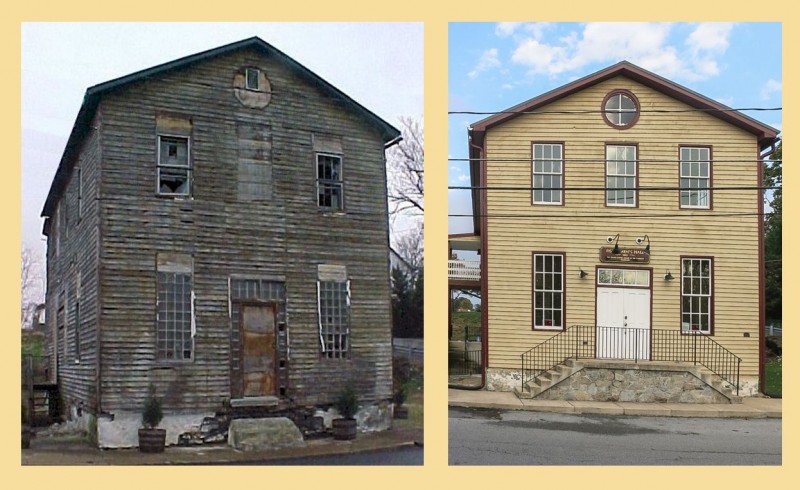|
By Ray Smock University President Suzanne Shipley led a group from Shepherd University for a tour of historical sites in Charles Town related to the rich African American heritage of this area. I was pleased to join her and Dr. Keith Alexander from the History Department, and Christana Johnson, Assistant Vice President for Student Affairs and Student Success. We toured three historic sites and came away with a better appreciation of the work being done by our hosts, members of the Jefferson County Black History Preservation Society, to save these sites and interpret them to visitors as part of the Jefferson County African American Heritage Trail. We were invited to visit the sites by Mr. James Taylor, Mr. George Rutherford, Mr. James Tolbert, and Ms. Linda Ballard who acted as our guides. The Byrd Center for Legislative Studies recently conducted oral history interviews with George Rutherford and James Tolbert regarding their relationship to Senator Byrd and the senator’s efforts to help preserve Fisherman’s Hall, one of the sites we visited. Even though Senator Byrd passed in 2010, an appropriation he earmarked for Fisherman’s Hall in 2009 is still helping with the restoration of this important building. Work was still going on in the final phase of the building’s restoration at the time of our visit. One site we visited, the James Webb House, was owned by free blacks beginning in the 1830s on a parcel of land once owned by George Washington’s brother Samuel. The small frame building expanded over time with different owners, eventually being purchased by a German immigrant, a baker, John Blessing, who befriended John Brown while Brown was incarcerated in Charles Town before he was hung for the raid on Harper’s Ferry in 1859. Brown gave Blessing an inscribed Bible for his kindnesses before going to the gallows. The Old Stone House (1795), one of the oldest stone structures in Charles Town, was purchased from Charles Washington, the town’s namesake and has serves as the home of Star Lodge #1. The structure is still owned by the Free and Accepted Masons. Donation bricks line the sidewalk showing some of the donors who have helped preserve this structure. A feature outside the Old Stone House, a plaque in honor of Martin Robison Delany, commemorates one of Charles Town’s most distinguished black citizens who served as the highest ranking black officer in the Union Army during the Civil War, and was an accomplished man in many fields such as medicine, writing, and as an explorer in Africa. The full story of this remarkable citizen of Jefferson County remains to be told. Fisherman’s Hall was our final stop and it is a model of historic preservation with the original hardwood floors appearing like new with a fresh, open, and inviting exterior and interior. The building was built in 1885 by the Charles Town Industrial Association during the post-Reconstruction era, when African American enterprise expanded despite the strictures of Jim Crow segregation. The building’s name derives from its use as a tabernacle for the Grand Order of United Galilean Fisherman, which promoted black enterprise and economic development. The building is used today for numerous public meetings and as a community center. One item on display inside the hall that really caught my attention was a marvelous photograph showing the attendees of the NAACP’s annual convention held in Harper’s Ferry in 1932. As a student of African American history, who spent the early part of my career editing the papers of Booker T. Washington and studying the early development of the Niagara Movement and the NAACP, I was delighted to see this photograph showing the great W. E. B. Du Bois and other founders and leaders of the NAACP including Walter White and James Weldon Johnson. The photo is a gem. And it was taken by the Washington, DC black photographer, Addison N. Scurlock who had a studio on U Street. His sons Robert and George kept the business going into the 1970s. I had the pleasure of meeting Robert Scurlock in the 1960s, when I was researching photographs on Booker T. Washington. Here is a link to a Smithsonian story about the Scurlock Studio: http://www.smithsonianmag.com/people-places/the-scurlock-studio-picture-of-prosperity-4869533/
Our tour was only a small part of the Jefferson County West Virginia African American Heritage Trail. A handsome brochure is available for download for those who want to see more. As the brochure states, “African American history in Jefferson County, West Virginia, cannot be separated from American history.” This is true. The only way to fully understand the broad contours of American history is to see it all as part of a fabric, intertwined and inseparable. The story is so much richer, exciting, and revealing when we embrace the whole thing. Comments are closed.
|
Welcome to the Byrd Center Blog! We share content here including research from our archival collections, articles from our director, and information on upcoming events.
Categories
All
Archives
July 2023
|
Our Mission: |
The Byrd Center advances representative democracy by promoting a better understanding of the United States Congress and the Constitution through programs and research that engage citizens.
|
Copyright © Robert C. Byrd Center for Congressional History and Education
|










 RSS Feed
RSS Feed
